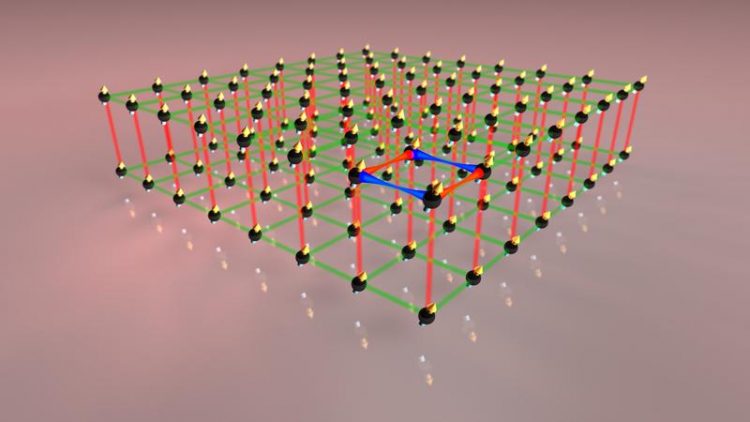Quantum Simulation 2.0: Atoms Chat Long Distance

By using a magnetic field physicists are able to directly change the direction of the mini magnets and precisely control how the particles interact – attracting or repelling each other. Erbium team/Simon Baier
Simulations are a popular tool to study physical processes that cannot be investigated experimentally in detail. For example, scientists are challenged to investigate physical processes in materials since their properties are determined by the interactions of single particles, which are hardly measurable directly.
Conventional computers quickly reach their limits when dealing with these complex simulations. At the beginning of the 1980s, Richard Feynman proposed to simulate these processes in a quantum system to overcome this obstacle.
Two decades later, Ignacio Cirac and Peter Zoller presented concrete concepts of how quantum processes could be studied by using ultracold atoms confined in optical lattices. In the last few years, this approach has proven itself in practice and is now broadly applied in experiments.
“We are able to control ultracold particles well in experiments and this has provided us with new insights into physical properties,” says Francesca Ferlaino from the Institute for Experimental Physics of the University of Innsbruck and the Institute for Quantum Optics and Quantum Information of the Austrian Academy of Sciences.
In collaboration with Peter Zoller’s team of theoretical physicists, her research team has now extended this approach for quantum simulations and laid the groundwork for future new research: For the first time, the physicists were able to quantitatively measure long-range interactions between magnetic atoms in optical lattices.
Experimental tool box for matter
Many studies have focused on the investigation of the interaction of short-range particles. “In contrast, we are working with strongly magnetic atoms, which can also interact over long distances,” says co-author Manfred Mark. For their experiment the physicists prepared an ultracold gas of erbium atoms – a Bose-Einstein condensate – in a three dimensional optical lattice of laser beams.
In this simulated solid-body crystal, the particles were arranged similar to eggs in a carton. The distance between the particles was seven times their wave function in the Innsbruck experiment. “By using a magnetic field we are able to directly change the direction of the mini magnets and precisely control how the particles interact – attracting or repelling each other,” explains first author Simon Baier.
A search for exotic quantum phases
“Our collaboration with Zoller, Cai Zi and Mikhail Baranov was indispensable for understanding our measurement results comprehensively,” underlines Francesca Ferlaino. “Our work is another important step towards a better understanding of quantum matter of dipolar atoms because their nature is a lot more complex than the atoms used for ultracold quantum gases in other experiments.”
The research results also lay the groundwork for future studies of novel exotic many-body quantum phases such as checkerboard and stripe phases, which may be created by long-range interactions. “Our study opens the door to finally being able to measure these type of phases,” says Simon Baier, who is already looking into the future. “In principle, we should be able to do this in our experiments as well but we will need to cool the atoms even further from currently 70nK to approximately 2nK.”
The research is supported by the Austrian Science Fund (FWF) and the European Research Council (ERC) among others.
Publication: Extended Bose-Hubbard models with ultracold magnetic atoms. S. Baier, M. J. Mark, D. Petter, K. Aikawa, L. Chomaz, Z. Cai, M. Baranov, P. Zoller, F. Ferlaino. Science 2016
DOI: 10.1126/science.aac9812
Contact:
Univ.-Prof. Dr. Francesca Ferlaino
Institute for Experimental Physics
University of Innsbruck
Phone: +43 676 872552440
Email: francesca.ferlaino@uibk.ac.at
Web: http://www.erbium.at
Dr. Christian Flatz
Public Relations Office
University of Innsbruck
Phone: +43 512 507 32022
Cell: +43 676 872532022
Email: christian.flatz@uibk.ac.at
http://www.erbium.at – Dipolar Quantum Gas Group
http://iqoqi.at – Institute of Quantum Optics and Quantum Information
http://www.uibk.ac.at/exphys/ – Department of Experimental Physics, University of Innsbruck
Media Contact
All latest news from the category: Physics and Astronomy
This area deals with the fundamental laws and building blocks of nature and how they interact, the properties and the behavior of matter, and research into space and time and their structures.
innovations-report provides in-depth reports and articles on subjects such as astrophysics, laser technologies, nuclear, quantum, particle and solid-state physics, nanotechnologies, planetary research and findings (Mars, Venus) and developments related to the Hubble Telescope.
Newest articles

NASA: Mystery of life’s handedness deepens
The mystery of why life uses molecules with specific orientations has deepened with a NASA-funded discovery that RNA — a key molecule thought to have potentially held the instructions for…

What are the effects of historic lithium mining on water quality?
Study reveals low levels of common contaminants but high levels of other elements in waters associated with an abandoned lithium mine. Lithium ore and mining waste from a historic lithium…

Quantum-inspired design boosts efficiency of heat-to-electricity conversion
Rice engineers take unconventional route to improving thermophotovoltaic systems. Researchers at Rice University have found a new way to improve a key element of thermophotovoltaic (TPV) systems, which convert heat…



